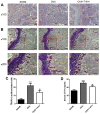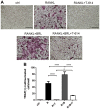Iguratimod prevents ovariectomy‑induced bone loss and suppresses osteoclastogenesis via inhibition of peroxisome proliferator‑activated receptor‑γ
- PMID: 28983607
- PMCID: PMC5779905
- DOI: 10.3892/mmr.2017.7648
Iguratimod prevents ovariectomy‑induced bone loss and suppresses osteoclastogenesis via inhibition of peroxisome proliferator‑activated receptor‑γ
Abstract
Iguratimod is known for its anti‑inflammatory activities and therapeutic effects in patients with rheumatoid arthritis. It has previously been demonstrated that iguratimod attenuates bone destruction and osteoclast formation in the Walker 256 rat mammary gland carcinoma cell‑induced bone cancer pain model. Therefore, it was hypothesized that iguratimod may additionally exhibit therapeutic effects on benign osteoclast‑associated diseases including postmenopausal osteoporosis. In the present study, ovariectomized mice were used to investigate the effects of iguratimod in vivo. Bone marrow mononuclear cells were cultured to detect the effects of iguratimod on receptor activator of nuclear factor‑κB ligand (RANKL)‑induced osteoclastogenesis in vitro and the molecular mechanisms involved. It was demonstrated that iguratimod may prevent ovariectomy‑induced bone loss by suppressing osteoclast activity in vivo. Consistently, iguratimod may inhibit RANKL‑induced osteoclastogenesis and bone resorption in primary bone marrow mononuclear cells. At the molecular level, peroxisome proliferator‑activated receptor‑γ (PPAR‑γ)/c‑Fos pathway, which is essential in RANKL‑induced osteoclast differentiation, was suppressed by iguratimod. Subsequently, iguratimod decreased the expression of nuclear factor of activated T cells c1 and downstream osteoclast marker genes. The results of the present study demonstrated that iguratimod may inhibit ovariectomy‑induced bone loss and osteoclastogenesis by modulating RANKL signaling. Therefore, iguratimod may act as a novel therapeutic to prevent postmenopausal osteoporosis.
Figures







Similar articles
-
Influence of Iguratimod on Bone Metabolism in Patients with Rheumatoid Arthritis: A Meta-analysis.Int J Clin Pract. 2022 Jul 21;2022:5684293. doi: 10.1155/2022/5684293. eCollection 2022. Int J Clin Pract. 2022. PMID: 35936067 Free PMC article. Review.
-
Iguratimod (T-614) suppresses RANKL-induced osteoclast differentiation and migration in RAW264.7 cells via NF-κB and MAPK pathways.Int Immunopharmacol. 2016 Jun;35:294-300. doi: 10.1016/j.intimp.2016.03.038. Epub 2016 Apr 16. Int Immunopharmacol. 2016. PMID: 27085680
-
Iguratimod inhibits osteoclastogenesis by modulating the RANKL and TNF-α signaling pathways.Int Immunopharmacol. 2021 Jan;90:107219. doi: 10.1016/j.intimp.2020.107219. Epub 2020 Dec 9. Int Immunopharmacol. 2021. PMID: 33307512
-
Desoxyrhapontigenin inhibits RANKL‑induced osteoclast formation and prevents inflammation‑mediated bone loss.Int J Mol Med. 2018 Jul;42(1):569-578. doi: 10.3892/ijmm.2018.3627. Epub 2018 Apr 17. Int J Mol Med. 2018. PMID: 29693149
-
Molecular mechanisms and clinical application of Iguratimod: A review.Biomed Pharmacother. 2020 Feb;122:109704. doi: 10.1016/j.biopha.2019.109704. Epub 2019 Dec 30. Biomed Pharmacother. 2020. PMID: 31918275 Review.
Cited by
-
Effectiveness and Safety of Iguratimod in Treating Primary Sjögren's Syndrome: A Systematic Review and Meta-Analysis.Front Pharmacol. 2021 Mar 19;12:621208. doi: 10.3389/fphar.2021.621208. eCollection 2021. Front Pharmacol. 2021. PMID: 33815105 Free PMC article. Review.
-
Iguratimod: a valuable remedy from the Asia Pacific region for ameliorating autoimmune diseases and protecting bone physiology.Bone Res. 2019 Sep 3;7:27. doi: 10.1038/s41413-019-0067-6. eCollection 2019. Bone Res. 2019. PMID: 31646017 Free PMC article. Review.
-
Influence of Iguratimod on Bone Metabolism in Patients with Rheumatoid Arthritis: A Meta-analysis.Int J Clin Pract. 2022 Jul 21;2022:5684293. doi: 10.1155/2022/5684293. eCollection 2022. Int J Clin Pract. 2022. PMID: 35936067 Free PMC article. Review.
-
Iguratimod Restrains Circulating Follicular Helper T Cell Function by Inhibiting Glucose Metabolism via Hif1α-HK2 Axis in Rheumatoid Arthritis.Front Immunol. 2022 Jun 1;13:757616. doi: 10.3389/fimmu.2022.757616. eCollection 2022. Front Immunol. 2022. PMID: 35720293 Free PMC article.
-
Effect of combined application of iguratimod in the treatment of active rheumatoid arthritis on bone metabolism, Th17 cells and Treg cells.Am J Transl Res. 2021 Mar 15;13(3):1676-1684. eCollection 2021. Am J Transl Res. 2021. PMID: 33841689 Free PMC article.
References
MeSH terms
Substances
LinkOut - more resources
Full Text Sources
Other Literature Sources

